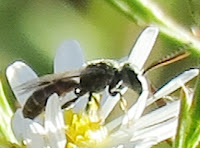 |
| Sweat Bee Family Halictidae, Tribe Halictini on Hairy Aster Creek Field, Oct. 2016 |
But with the extended and oddly warm fall, pollinators kept going even after the Tall Thistle had gone to seed.
Then, late, late bloomers became important!
 |
| Sweat Bees (Halictidae, Tribe Halictini) on Hairy Aster October 2016 Creek Field |
Especially beneficial was Hairy Aster (Symphiotricum pilosum), a total volunteer in the Creek Field. This perennial bloomed in late September and continued blooming throughout October.
Sweat Bees (pictured above & in the video below) loved the Hairy Asters!
However, Black Blister Beetles (Epicauta pennsylvanicus) were also all over the Hairy Asters. Here they are in the October Creek Field, munching on the petals of Hairy Aster, grooming themselves, and tapping each other in puzzling but suggestive ways.
The role of beetles in pollination is not as well known as the role of bees. But we can see that these beetles certainly move from flower to flower. And is that pollen we see glistening on their bodies?
Moths and flies are also important pollinators.
Here are two moths I found on the Hairy Asters in October: The Two-Spotted Herpetogramma, also known as the Southern Beet Webworm, is on the left, and the Beet Webworm Moth is on the right.
 |
| Herpetogramma bipunctalis on Hairy Aster Southern Beet Webworm Moth or Two-Spotted Herpetogramma Creek Field, October 2016 |
 |
| Spoladea recurvalis Beet Webworm Moth on Hairy Aster Creek Field, October 2017 |
The two are in the same family (Crambid Snout Moths, Crambidae), but are in different genera. However, their similar common names suggest they are both obnoxious to beet-growers!
 |
| Fly on Hairy Asters Creek Field October 2016 |
This gorgeously iridescent fly is either a member of the Calliphoridae family (blow flies) or the Muscidae family, genus Neomyia (Neomyia larvae live in dung).
 |
| A gorgeously iridescent fly (family Calliphoridae [blow-flies] or family Muscidae, genus Neomyia [larvae live in dung) feeding on Hairy Aster Creek Field, October 2016 |
In the video below a Tachinid fly visits Hairy Asters while Halictini Sweat Bees try to get some of the goodies, too.
Tachinid flies lay eggs on caterpillars. The fly larvae are parasitoids--meaning they develop inside the living body of a host, ultimately killing it.
Also valuable as a late, late bloomer is Gaillardia pulchella, Indian Blanket or simply Gaillardia. Gaillardia is a native annual that blooms early in the season and then sets seeds. But if the season goes on long enough, those seeds germinate, and Gaillardia blooms again.
Some Gaillardia bloomed in October! Here on the left is a delightful little Grass Skipper (Lerodea eufala) nectaring on a late-blooming Gaillardia.
 |
| A grass skipper Lerodea eufala nectars on Gaillardia pulchella. Creek Field, October 2016 |
 |
| Orange Sulphur (Colias eurytheme) crossed with Clouded Sulphur (Colias philodice) creates this hybrid. The Sweat Bee to the left of the Sulphur is in the genus Agapostemon--Metallic Green Bees |
On the right is a hybrid butterly --a cross between an Orange Sulphur and a Clouded Sulphur--nectaring on a late-blooming Gaillardia. That's a Sweat Bee--what else--to the left of the Sulphur!
Thank you so much, Hairy Asters and Gaillardia!
You were late, late bloomers, just like some pollinators.
You gave the pollinators somewhere to go.